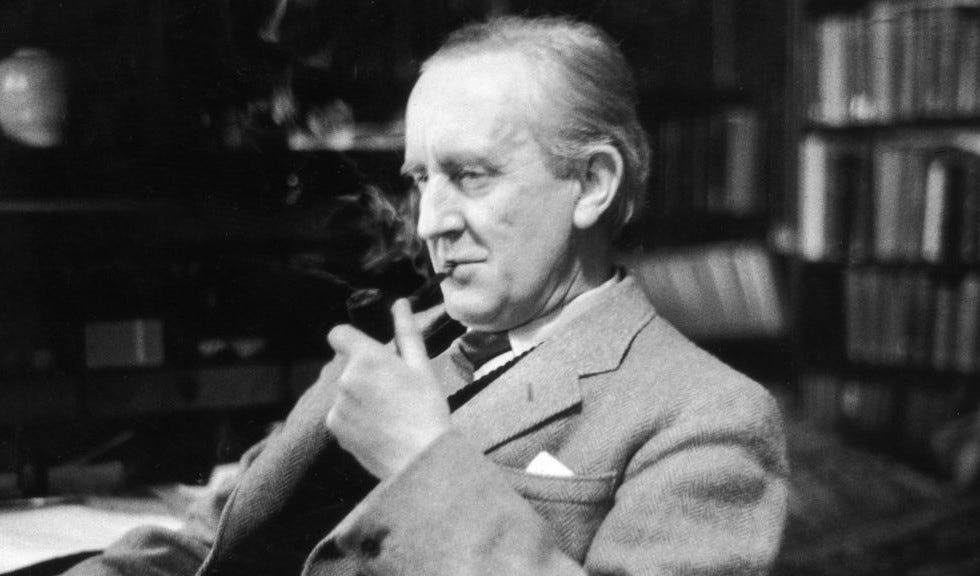I have been listening to Rob Inglis’ rather magnificent audiobook performance of The Lord of the Rings, and I’ve been struck by a minor locution of Tolkien’s that I’d noticed before in the Aubrey-Maturin novels. This is the habit of inverting the syntax of the dialogue tag. Instead of using Gandalf said or Jack said to identify the speakers of dialogue, these English tale-spinners resort to said Gandalf and said Jack. I pluck down my copy of The Return of the King and select at random:
“This is the storehouse and buttery of my company of the Guard,” said Beregond.
…
“I parted with them in the morning two says ago,” said Faramir.
…
“But we can’t,” said Sam, “not without wings.
As for Patrick O’Brian, a quick consultation with the very helpful POB text search website, a digital concordance the complete canon of 21 books, informs me of 2,633 uses of the phrase “said Jack” to 204 uses of “Jack said,” and 2,218 uses of “said Stephen” to 213 uses of “Stephen said.” What does it mean?
To my ear (especially when listening to the audiobooks), this inversion has an archaic quality that enhances the orality of the text—there’s something storybook about “said Jack.” The syntax of such phrases puts a subtle emphasis on the name of the speaking character, rather than on the action “said.” It elevates their stature—there’s a touch of the epic to syntax that emphasizes the actor. In the examples from Tolkien, above, the characters are mixed in stature: Beregond is a minor character, a guard in Minas Tirith befriended by Merry Brandybuck; Faramir is a lord, son of the Steward of Gondor; Sam is the lowliest of the four hobbits, with the habit of referring to Frodo as “Master.” Tolkien seems to prefer normal syntax with pronouns: on a couple of facing pages of “The Houses of Healing” I see "“said Aragorn” next to “she answered,” “said the man” beside “he said.” There are 118 “said he’s” in the Aubrey-Maturin books, compared with 3,238 “he said’s”; 323 “she said’s” and only 49 “said she’s.” That makes sense to me; “said he” somehow sounds more archaic than “said Stephen.”
As a general rule, my feeling about dialogue tags is that they should be invisible, mere identifiers of who happens to be speaking; it grieves me when students who’ve been told by well-meaning teachers that “said is dead” write dialogue in which characters state, reply, utter, and smile (there’s a cold place in hell for whoever first thought to use smile as a dialogue tag). In the case of Tolkien and O’Brian, who are writing stories set in a mythic past (the former’s past is obviously more mythic than the latter’s), the inverted dialogue tags subtly reinforce the orality of the text and thus the ghost of epic poetry, even as both writers (but especially O’Brian") write sentences of a length and complexity that seem to demand the logic of literacy and the printing press. Tolkien of course was a scholar of Anglo-Saxon epic, especially Beowulf; O’Brian frequently demonstrates a familiarity and facility with the preferred form of 18th-century epic verse, the heroic couplet. O’Brian is a bit harder to follow than Tolkien when listened to rather than read; I think he is more interested than Tolkien in the tension between speech and writing, as he carefully conjures the impression of early 19th-century English literature without simply imitating it.
You might think that focusing on this sort of quibbling detail, this pilpul-like combing of the least threads of prose, would detract from the mere pleasure of reading, but nothing could be further from the truth! For years I immersed myself primarily in the literature of modernism; now I seem to be preoccupied by fiction written under modern conditions that transcends, I think, mere conservatism or nostalgia by the detail of the narrative worlds that it conjures. Both Tolkien and O’Brian pleasurably overwhelm their readers with the details of their elf-lore and their sea battles. But the dense visuality of the worlds they conjure cannot be discriminated from the density and playfulness of their language, which is ultimately all we readers really have. Both writers offer their readers the illusion of fluency (in elvish or in sea terms), an illusion paradoxically enhanced by the fact that comparatively few of their readers are going to go to the trouble of actually speaking elvish or sailing a square-rigger. Fluency, flow. The slightly impeded syntax of “said Jack” and “said Aragorn” intensifies the illusion that we have been caught up in a river of speech as wild and various as the world itself.






I am excited to get to read this kind of analysis of some of the literature that I love. My first choice of college, back in the late 60s, was a place where I hoped to major in literature. My dad, though, dreamed of his firstborn son becoming some kind of medical professional, the cinder of a frustrated image from his own youth, and blocked my route to that life. Thanks for your newsletter. I find it a deeply satisfying experience! The deliberate archaisms employed by Tolkien and O’Brian are very interesting “tells”!